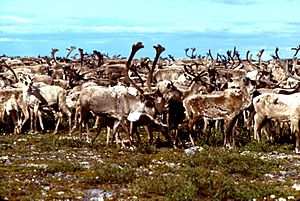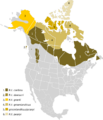Barren-ground caribou facts for kids
The barren-ground caribou (Rangifer tarandus groenlandicus) is a type of reindeer found mostly in Canada's Nunavut and Northwest Territories, and also in Kitaa, Greenland. Sometimes, the similar-looking Porcupine caribou is included, which means this caribou can also be found in Alaska.
Barren-ground caribou are medium-sized. They are smaller and lighter in color than the boreal woodland caribou. Females usually weigh about 90 kg (200 lb), and males weigh around 150 kg (330 lb). However, caribou on smaller islands might weigh less.
Large groups of barren-ground caribou are named after their traditional calving grounds. These include the Ahiak herd, the Baffin Island herds, the Bathurst herd, the Beverly herd, the Bluenose East herd, the Bluenose West herd, the Porcupine herd, and the Qamanirjuaq herd.
Quick facts for kids Barren-ground caribou |
|
|---|---|
 |
|
| Barren-ground caribou herd near the Thelon River | |
| Scientific classification |
|
| Kingdom: | Animalia |
| Phylum: | Chordata |
| Class: | Mammalia |
| Order: | Artiodactyla |
| Family: | Cervidae |
| Subfamily: | Capreolinae |
| Genus: | Rangifer |
| Species: | |
| Subspecies: |
R. t. groenlandicus
|
| Trinomial name | |
| Rangifer tarandus groenlandicus (Borowski, 1780)
|
|
 |
|
| Approximate range of barren-ground caribou. Overlap with other subspecies of caribou is possible for contiguous range. 1.Rangifer tarandus caribou, which is subdivided into ecotypes: boreal woodland, migratory woodland and mountain woodland; 2. R. t. dawsoni (extinct 1908); 3. R. t. granti; 4. R. t. groenlandicus; 5. R. t. groenlandicus/pearyi; 6. R. t. pearyi | |
Contents
Where Do Barren-Ground Caribou Live?
About half of all caribou in Canada are barren-ground caribou. They spend most of the year on the open, treeless land called the tundra. This area stretches from Alaska all the way to Baffin Island.
Most of these caribou, about 1.2 million, live in eight big groups that move with the seasons. They travel from the tundra to the taiga, which are forests with scattered trees south of the tundra. These herds include the Porcupine, Cape Bathurst, Bluenose West, Bluenose East, Bathurst, Ahiak, Beverly, and Qamanirjuaq herds.
Around 120,000 other barren-ground caribou live in smaller groups. These groups stay on the tundra all year. Half of them live only on Baffin Island.
What Do Barren-Ground Caribou Look Like?
Like the Peary caribou, both male and female barren-ground caribou have antlers. In summer, their fur is usually brown. It becomes much lighter in winter. Their neck and rump often look creamy-white. However, their exact color can change depending on where they live.
How Do Barren-Ground Caribou Live?
Barren-ground caribou usually breed in the fall. Females give birth to a single calf in June, or sometimes in July. The female often gives birth away from the main herd, if possible, on a patch of snow. After the birth, the mother licks her calf clean. She also eats the tissues and the placenta. This might help her get back nutrients lost during birth. It also helps remove any scent that could attract predators.
Their main food is lichen, which is a type of moss-like plant. They also eat Cyperaceae (sedges), grasses, twigs, and mushrooms. Caribou have also been seen eating antlers, seaweed, and licking salt deposits. Some evidence suggests they might sometimes eat small rodents like lemmings, fish like Arctic char, and bird eggs.
On the Canadian mainland, caribou can travel in herds of thousands. However, on islands, they move in smaller groups of no more than 50. They are migratory animals, meaning they travel long distances. They can journey up to 1,200 km (750 miles) in one season. Some groups, like those on Victoria Island in summer, move to the mainland in the fall. This happens after the sea ice has formed. At this time, smaller groups can join together to form a larger herd of hundreds of animals.
Mainland barren-ground caribou herds usually move to coastal areas for part of the year. The Beverly herd is an exception.
Caribou Herds: Beverly and Qamanirjuaq
The Beverly herd is found mostly in Saskatchewan and the Northwest Territories. Parts of it are also in Nunavut, Manitoba, and Alberta. The Qamanirjuaq herd is mainly in Manitoba and Nunavut. It also extends into the southeastern NWT and northeastern Saskatchewan. These two herds are managed by the Beverly and Qamanirjuaq Caribou Management Board.
The Beverly herd's range covers the tundra from northern Manitoba and Saskatchewan into the Northwest Territories and Nunavut. In 1994, a survey counted 276,000 caribou, which was a record high. However, a 2011 survey showed about 124,000 caribou in the Beverly herd. The Ahiak herd had about 83,300 caribou.
The Beverly herd's calving grounds are usually around Queen Maud Gulf. But the herd has shifted its traditional birthing area. Experts believe the low birth rate is mainly due to changes in their habitat and disturbances. Other factors like parasites, predators, and bad weather also play a role.
Some experts, like John Nagy from the University of Alberta, believe the Beverly herd is not declining. He thinks the herd simply moved its calving grounds. He based his findings on data from 510 caribou tracked with satellite collars from 1993 to 2009.
Caribou and Indigenous Peoples
The barren-ground caribou is called tuktu in Inuinnaqtun/Inuktitut. It is a very important food source for the Inuit people. This is especially true for the Caribou Inuit groups living in the Kivalliq Region of Nunavut.
Predators of the Caribou
The main predator of barren-ground caribou is the Arctic wolf (Canis lupus arctos). Wolves may follow the caribou herds for many miles. Caribou have poor eyesight and hearing. However, they are very fast and can usually outrun a wolf.
Dolphin-Union Caribou Herd
The Dolphin-Union caribou herd is also known as the island caribou. These barren-ground caribou live on Victoria Island in Canada's High Arctic and the nearby mainland. They are unique to Canada.
They travel across the Dolphin and Union Strait. In summer, they graze on Victoria Island. In winter, they move to their grazing area on the Nunavut-NWT mainland. It is unusual for North American caribou to cross sea ice every season. The only other caribou subspecies that does this is the Peary caribou (R. t. pearyi). Peary caribou are smaller in size and population.
What Threats Do Caribou Face?
Climate Change Impacts
In 2004, the Canadian Government's Species at Risk (SARA) registry listed barren-ground caribou as a species of "special concern." This status was given because climate change was negatively affecting their population. It is predicted that changing climate conditions in the Arctic will threaten barren-ground caribou soon.
The risks from climate change can affect their feeding habits. It can make it harder for them to find food or reduce the quality of their food. It can also impact birth rates and how well calves survive. Caribou might have to travel longer distances. Thinning ice during migration and more insects are also problems.
Food Challenges
Climate change makes it harder for barren-ground caribou to find food. Extreme weather can bring more rain and freezing rain in winter. This creates a layer of ice that blocks access to lichen, their main food. Frozen feeding grounds in winter mean caribou use more energy trying to reach the lichen under the ice. This can lead to them not getting enough food, starving, and even dying.
Research shows that climate changes can make lichen in the Arctic less nutritious. A changing climate also brings new plant species to the region. These new plants compete with the caribou's usual food sources.
Calving Season Problems
Barren-ground caribou have adapted to have their calves when lichen traditionally blooms. This timing between giving birth and having easily available lichen is very important for the calves' survival. However, unusual temperature changes due to climate change are disrupting this timing. This leads to young caribou not getting enough food. It also reduces how many calves are born, which causes the population to decline.
Migration Difficulties
The timing of caribou migrations is closely linked to seasonal changes. As unpredictable climate conditions increase, barren-ground caribou must travel longer distances. Their migration is guided by where they can easily find lichen. Traveling longer distances puts more stress on the caribou and uses up more of their energy.
Warmer weather also makes ice thinner over rivers and lakes. This makes it hard for caribou to cross. Less ice creates a natural barrier, breaking up their migration paths. This stops caribou from reaching their yearly feeding and breeding grounds. Unpredictable migration patterns also hurt Indigenous communities. These communities depend on caribou for food and income.
Insect Harassment
Another problem for barren-ground caribou is irritation from insects. Insect behavior can affect where caribou move and how healthy they are during summer. Warmer temperatures and early springs lead to more insects. Insect harassment forces caribou to move to areas that might still be covered in snow or ice. This reduces their access to food.
Caribou give birth in early spring when insect numbers are low. This allows their calves to grow healthy and strong. Early spring temperatures in the Arctic also affect the timing of caribou pregnancies. Avoiding insects makes caribou use a lot of energy by migrating away from them. Climate changes can also increase the number of parasites, adding another threat to the caribou.
Images for kids
-
Approximate range of barren-ground caribou. Overlap with other subspecies of caribou is possible for contiguous range. 1.Rangifer tarandus caribou, which is subdivided into ecotypes: boreal woodland, migratory woodland and mountain woodland; 2. R. t. dawsoni (extinct 1908); 3. R. t. granti; 4. R. t. groenlandicus; 5. R. t. groenlandicus/pearyi; 6. R. t. pearyi
See also
 In Spanish: Rangifer tarandus groenlandicus para niños
In Spanish: Rangifer tarandus groenlandicus para niños



